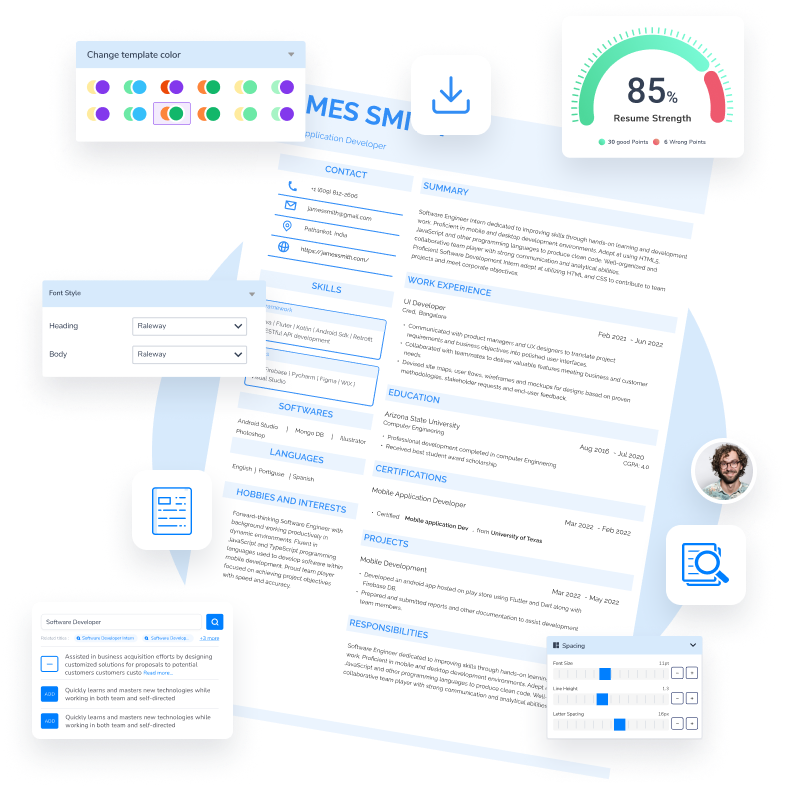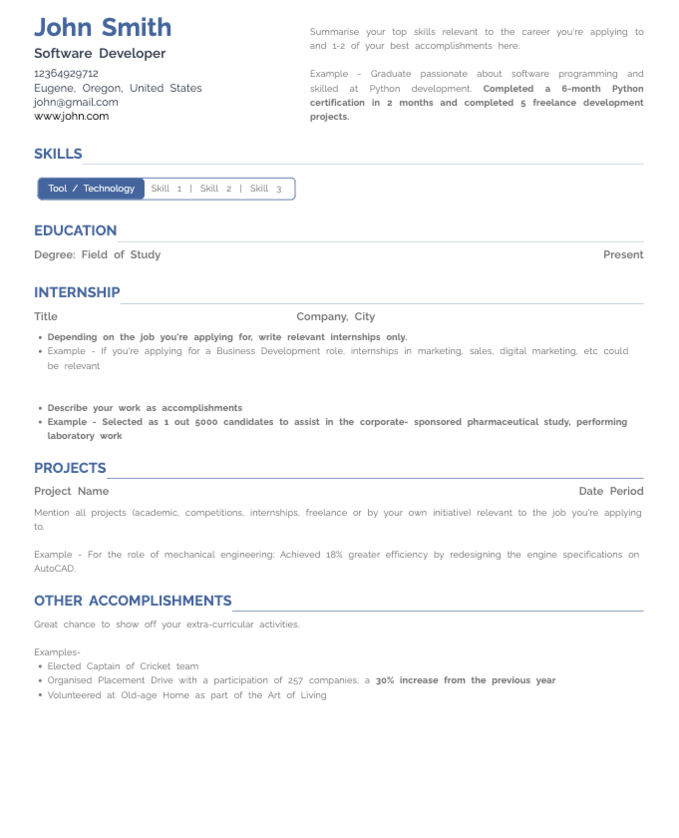12+ Tricks to Craft a Resume For Physiotherapist Jobs in 2023
8 min read

Your resume is your first opportunity to make a lasting impression on potential employers.
When applying for physiotherapist jobs in 2023, it's essential to craft a resume that effectively highlights your qualifications, skills, and experiences.
For that, we are here with some practical tricks to craft a professional physiotherapist resume in 2023. You will get answers to the following physiotherapist career-building queries here:
- What are the fundamental duties of a physiotherapist?
- How to use the job description to make a physiotherapist resume?
- How to build a physiotherapist resume?
- Is a cover letter required with a physiotherapist resume?
You can avoid the entire resume-building hassle by using the HyreSnap Online Resume Builder for your physiotherapist resume in 2023.
It is a marvelous AI-based resume building platform that offers the first 3 resumes for free. You can make your physiotherapist resume using this AI resume builder in less than 15 minutes.
However, if you want to learn the resume-building process, start reading these guidelines and build your professional physiotherapist resume:
Physiotherapists play a crucial role in helping individuals recover from injuries, surgeries, and medical conditions, and improving their overall physical well-being. Their fundamental duties encompass a range of responsibilities aimed at promoting optimal health and mobility. Here are the fundamental duties of a physiotherapist:
- Assessment and Evaluation: Conduct comprehensive assessments to determine a patient's physical condition, limitations, and specific needs.
- Treatment Planning: Develop individualized treatment plans based on assessment findings, patient goals, and evidence-based practices.
- Physical Rehabilitation: Provide hands-on therapy, exercises, and techniques to improve mobility, strength, and function in patients with musculoskeletal, neurological, or cardiopulmonary conditions.
- Pain Management: Address pain through various therapeutic modalities, such as manual therapy, electrical stimulation, and hot/cold therapies.
- Patient Education: Educate patients and their families about their conditions, treatment options, and preventive measures to maintain and enhance their health.
- Exercise Prescription: Prescribe tailored exercise programs that patients can perform independently to improve their physical condition and prevent future injuries.
- Mobility and Gait Training: Help patients regain the ability to walk and move safely, particularly after surgeries or injuries.
- Assistive Device Recommendation: Assess the need for and recommend assistive devices such as crutches, walkers, or wheelchairs to enhance mobility.
- Respiratory Care: Assist patients with breathing difficulties, teaching breathing exercises and techniques to improve lung function.
- Postural Correction: Address posture-related issues and recommend ergonomic changes in work or home environments.
- Pregnancy and Postpartum Care: Provide care and guidance to pregnant women for managing physical discomfort and postpartum recovery.
- Pediatric Care: Work with children to address developmental delays, congenital conditions, and injuries.
- Geriatric Care: Focus on improving the quality of life for elderly patients by addressing mobility and functional issues related to aging.
- Sports Rehabilitation: Assist athletes in recovering from sports-related injuries and enhancing their performance through specific rehabilitation programs.
- Neurological Rehabilitation: Work with patients who have neurological disorders like stroke, multiple sclerosis, or Parkinson's disease to improve motor function and independence.
- Orthopedic Rehabilitation: Specialize in the rehabilitation of musculoskeletal conditions, such as fractures, joint replacements, and sports injuries.
- Cardiopulmonary Rehabilitation: Help patients recovering from heart or lung surgeries and conditions to regain cardiovascular and pulmonary function.
- Wound Care: Manage wounds, ulcers, and bedsores by employing appropriate therapies and wound dressings.
- Record Keeping: Maintain accurate and confidential patient records, documenting assessments, treatment plans, progress, and outcomes.
- Continuing Education: Stay current with the latest research and developments in physiotherapy through ongoing professional development and education.
- Interdisciplinary Collaboration: Work closely with other healthcare professionals, including doctors, nurses, and occupational therapists, to provide comprehensive care to patients.
- Ethical Practice: Adhere to professional and ethical standards, including patient confidentiality and informed consent.
- Cultural Competence: Respect and consider cultural differences when providing care to a diverse patient population.
- Safety and Infection Control: Ensure a safe and clean treatment environment, adhering to infection control protocols.
- Advocacy: Advocate for the health and well-being of patients, promoting the importance of physical therapy in healthcare systems.
You can leverage the physiotherapist job description to improve the technical strength of your resume. A job description provides you with technical keywords that you can use while building your physiotherapist resume to parse through the ATS screening process without any hurdles. Below you can see a real life physiotherapist job description to understand better:
Physiotherapist Job Description Example:
We are seeking a dedicated and compassionate Physiotherapist to join our dynamic healthcare team at XYZ Hospital. As a Physiotherapist, you will play a crucial role in assessing, planning, and implementing rehabilitation programs to help patients regain mobility, alleviate pain, and improve their overall physical well-being.
Key Responsibilities:
- Conduct comprehensive assessments of patients to evaluate their physical condition, limitations, and specific needs.
- Develop individualized treatment plans based on assessment findings, patient goals, and evidence-based practices.
- Provide hands-on therapy, exercises, and techniques to improve mobility, strength, and function in patients with musculoskeletal, neurological, or cardiopulmonary conditions.
- Address pain through various therapeutic modalities, such as manual therapy, electrical stimulation, and hot/cold therapies.
- Educate patients and their families about their conditions, treatment options, and preventive measures to maintain and enhance their health.
- Prescribe tailored exercise programs that patients can perform independently to improve their physical condition and prevent future injuries.
- Assist patients in regaining the ability to walk and move safely, particularly after surgeries or injuries.
- Assess the need for and recommend assistive devices such as crutches, walkers, or wheelchairs to enhance mobility.
- Collaborate with other healthcare professionals, including doctors, nurses, and occupational therapists, to provide comprehensive care to patients.
- Maintain accurate and confidential patient records, documenting assessments, treatment plans, progress, and outcomes.
- Stay current with the latest research and developments in physiotherapy through ongoing professional development and education.
- Adhere to professional and ethical standards, including patient confidentiality and informed consent.
- Create a safe and clean treatment environment, adhering to infection control protocols.
Qualifications:
- Bachelor's or Master's degree in Physiotherapy from an accredited institution.
- Valid state licensure as a Physiotherapist.
- CPR certification.
- Strong clinical assessment and rehabilitation skills.
- Excellent communication and interpersonal abilities.
- Compassionate and patient-centered approach to care.
- Ability to work collaboratively in a healthcare team.
- Prior experience in a hospital or clinical setting is preferred but not required.
Building an effective physiotherapist resume is essential to showcase your qualifications, experience, and skills to potential employers. Here's a step-by-step guide on how to create a compelling physiotherapist resume:
Choose The Right Resume Format
Opt for a reverse chronological format, which highlights your most recent work experience first. This is the most common format for healthcare professionals.
Contact Information
Include your full name, professional title (Physiotherapist), phone number, email address, and LinkedIn profile (if applicable). Ensure your contact information is up to date.
Resume Summary or Objective
Write a concise, well-crafted summary or objective statement that briefly describes your career goals and what you bring to the role. Highlight any specializations or certifications.
Professional Experience
List your work experience in reverse chronological order. Include the following details for each position:
- Job title
- Name of the healthcare facility or clinic
- Location (city and state)
- Employment dates (month and year)
Additionally, we recommend describing your responsibilities and achievements in bullet points. Emphasize your ability to assess, plan, and implement rehabilitation programs, as well as any specialization areas (e.g., sports rehabilitation, pediatric care, geriatric care).
Use action verbs to start each bullet point (e.g., "Assessed patients' physical conditions..."). Lastly, quantify your achievements where possible (e.g., "Achieved a 20% improvement in patients' mobility within three months").
Education
List your educational background, starting with your highest degree earned and working backward. Include the following details:
- Degree earned (e.g., Master of Physiotherapy, Bachelor of Science in Physiotherapy)
- Name of the educational institution
- Graduation date (month and year)
- Relevant coursework or specializations
If you have certifications or additional training (e.g., CPR certification, specialized courses), mention them in this section.
Licensure and Certifications
Include your state or country licensure as a physiotherapist and any relevant certifications, such as specialization certifications or first aid/CPR certifications.
Skills
Highlight your key skills in a dedicated section. Include both technical skills (e.g., manual therapy, exercise prescription) and soft skills (e.g., communication, empathy).
Professional Memberships
If you are a member of any professional associations (e.g., American Physical Therapy Association), mention them in this section.
Clinical Rotations or Internships (Optional)
If you are a recent graduate or have limited work experience, consider including information about relevant clinical rotations or internships to demonstrate practical experience.
Awards and Achievements (Optional)
Include any awards, scholarships, or recognitions you have received related to your field.
Continuing Education (Optional)
If you regularly attend workshops, seminars, or conferences to stay updated in your field, mention them in this section.
References (Available Upon Request)
You don't need to provide references on your resume, but you can mention that they are available upon request. Make sure you have your references prepared separately.
Formatting Tips
- Use a clean and professional font (e.g., Arial, Calibri) and maintain consistent formatting throughout the resume.
- Keep the document well-organized with clear headings and bullet points for easy readability.
- Use a professional tone and avoid jargon or acronyms that may not be universally understood.
Proofread and Edit
- Carefully proofread your resume to eliminate spelling and grammar errors.
- Ensure that the content is concise and relevant to the position you're applying for.
Online Presence
Ensure that your LinkedIn profile is up to date and complements your resume. Many employers may review your online presence as part of the hiring process.
By following these steps and tailoring your resume to the physiotherapy position you're seeking, you'll increase your chances of standing out to potential employers in the healthcare field.
To ease your resume-building process and help you understand every step mentioned above, we are listing a physiotherapist resume sample below. You can refer to this sample while building your physiotherapist resume to organize every section effectively.
Physiotherapist Resume Sample:
[Your Name]
[Your Address]
[City, State, ZIP Code]
[Your Phone Number]
[Your Email Address]
[LinkedIn Profile (optional)]
Objective:
Dedicated and licensed physiotherapist with [X] years of experience in musculoskeletal and sports rehabilitation. Committed to delivering patient-centered care and optimizing physical function. Seeking an opportunity to apply my expertise in a dynamic healthcare setting.
Skills:
- Musculoskeletal Assessment
- Manual Therapy Techniques
- Exercise Prescription
- Injury Prevention
- Rehabilitation Programs
- Sports Medicine
- Patient Education
- Electronic Health Records (EHR)
- Interdisciplinary Collaboration
- Communication Skills
Professional Experience:
Physiotherapist
ABC Physiotherapy Clinic, [City, State]
[Month Year] - Present
- Assess and diagnose musculoskeletal conditions, injuries, and disabilities.
- Develop and implement individualized treatment plans based on clinical assessments and patient goals.
- Provide hands-on manual therapy, therapeutic exercises, and modalities to improve mobility, reduce pain, and enhance function.
- Collaborate with a multidisciplinary healthcare team to ensure comprehensive patient care.
- Conduct patient education sessions on injury prevention, rehabilitation exercises, and home care.
- Utilize advanced techniques, including dry needling and kinesiology taping, to optimize treatment outcomes.
- Document patient progress, maintain accurate records, and report to referring physicians.
Physiotherapist
XYZ Sports Rehabilitation Center, [City, State]
[Month Year] - [Month Year]
- Specialized in sports-related injuries and worked with athletes of all levels.
- Conducted pre-participation screenings and fitness assessments.
- Designed and implemented sport-specific rehabilitation programs to facilitate safe return to play.
- Collaborated with sports coaches and trainers to coordinate athlete care and conditioning.
- Utilized cutting-edge technologies, such as video analysis, to assess and refine movement patterns.
- Administered manual therapy techniques, including joint mobilizations and soft tissue manipulation.
- Conducted injury prevention workshops for sports teams and local organizations.
Education:
Master of Physiotherapy (MPT)
[University Name], [City, State]
[Graduation Month Year]
- Specialization in Orthopedics and Sports Physiotherapy
- Relevant Coursework: Advanced Musculoskeletal Assessment, Exercise Prescription, Research Methodology
Bachelor of Science in Physiotherapy (BScPT)
[University Name], [City, State]
[Graduation Month Year]
Licenses and Certifications:
- Licensed Physiotherapist, [State/Country], License Number: [License Number]
- Certified in CPR and Basic Life Support (BLS)
Professional Memberships:
- Member, American Physical Therapy Association (APTA)
Professional References:
Available upon request.
Yes, a cover letter is important when submitting your physiotherapist resume. While not all employers may require a cover letter, including one can significantly enhance your job application for several reasons:
- Personalization: A cover letter allows you to personalize your application by addressing the hiring manager or recruiter by name. It shows that you've taken the time to research the organization and are genuinely interested in the position.
- Highlighting Your Fit: You can use the cover letter to explain why you're a great fit for the specific physiotherapy role and the healthcare facility. Highlight your skills, experiences, and qualifications that align with the job requirements.
- Addressing Gaps or Special Circumstances: If you have gaps in your employment history, are transitioning from a different field, or have other unique circumstances, a cover letter provides an opportunity to address these issues and explain how your background is relevant.
- Showcasing Your Communication Skills: As a healthcare professional, effective communication is essential. Your cover letter demonstrates your ability to convey your thoughts clearly and concisely.
- Demonstrating Enthusiasm: A well-written cover letter can convey your enthusiasm for the position and the organization, which can make a positive impression on employers.
- Highlighting Specific Achievements: You can use the cover letter to briefly discuss specific achievements or experiences that are particularly relevant to the job. This can provide context for your resume.
- Expressing Your Motivation: Explain why you're interested in working at the specific healthcare facility. Is it their reputation for patient care, commitment to innovation, or a personal connection? This demonstrates that you've done your homework and are genuinely interested.
- Requesting an Interview: A cover letter serves as a formal request for an interview. Politely express your desire to discuss your qualifications further in an interview setting.
- Providing a Professional Introduction: A cover letter provides a professional introduction and context for your resume. It's an opportunity to make a positive first impression.
- Compliance with Employer Preferences: Some employers specifically request a cover letter as part of the application process. Failing to include one when it's requested may result in your application being overlooked.
You can follow all the above-given resume-building steps to craft a job-winning physiotherapist resume on your own. However, you can also make the process easy by using HyreSnap Online Resume Builder. It is a modern AI-powered resume-making platform that is capable of building ATS-freindly resumes in less than 15 minutes.
Below you can check the key features of this modern resume builder:
We have listed all the important instructions to build a physiotherapist resume above. To revise everything, you can check the key takeaways below:
- Choose a professional resume format, i.e., reverse chronological or combination
- Outline your resume with the help of all essential resume sections
- Write your resume summary/objective after writing all other resume parts
- Use one-liner bullet points to mention your resume details except the summary
- List your technical and soft skills separately to get better visibility
- Proofread your resume after some time of completing your resume
For more details or any other career-building assistance, you can contact our experts at info@hyresnap.com. Our team is completely determined to help every job seeker build a bright career.

Try Now for Free!




